While in self-isolation during the COVID-19 pandemic, I am keeping a daily diary—to pass the time and record moments and experiences during this unusual time.

How Cycling Can Change the Look and Feel of Toronto and How Covid 19 May be Pointing the Way
Post Date: Thursday July 3, 2020
We are becoming a biking city almost in spite of ourselves. There have never been so many of us on bikes. Bike sales have outstripped supplies; bike stores can’t keep up with the demand and bike share is expanding its territory into the inner suburbs. But we are still in early stages of making it safe and comfortable for many users. We have inherited streets designed essentially for moving cars, and while we have a growing number of bike lanes and off-street trails, they are still sparse, relatively few and far between. We have been timid thus far but can we now see an image on the horizon of a different city propelled by Covid-19which is bike friendly? Is this a mirage or a growing reality? Can we make the change more quickly and more nimbly?
Covid-19 has shone a light on what is working and what is not in many areas, and has raised the ante. As restrictions begin to be lifted, Toronto is joining the dozens of cities around the world – Berlin, Bogota, New York, Paris, Oakland, Milan, Vilnius, Vancouver, Calgary to name just a few - that are rapidly expanding networks of safe ways to move around the city during the pandemic, turning over hundreds of kilometers of traffic lanes and in many cases entire streets to pedestrians and cyclists.
This shift is both an answer to the practical need for new ways of navigating the city on foot and by bike to get to work and essential shopping and also a way of addressing the insatiable desire to be outdoors while respecting physical distancing. A new form of ‘Emergency Urbanism’ is revealing the promise of what could be. A slow march has become a quick step as improvised ‘pilots’ expand the realm of the possible, testing hard-wired assumptions about what works. As this happens, this response is revealing an entirely new way of using the city laced by interconnected bike lanes.
This response is a powerful demonstration of city resilience, providing essential choices and work-arounds in a moment of crisis but also pointing the way to adaptations that have great potential to become permanent. As we experience the change, the momentum is unlikely to be reversed. Toronto has been slow off the mark but this can also be the city’s opportunity to boldly join the parade.
This ‘improvised’ shift is dramatically accelerating a movement that was already underway. Toronto is evolving into a great and densely populated city. It has a wide range of existing parks and trails including the Martin Goodman Trail across the waterfront, trails in the ravines and river valleys, and a limited number of protected on street bike lanes. What we are still missing, however, is a fully interconnected city-wide network for real transportation as well as for recreation.
This Covid-19 crisis has put a premium on public spaces where people of all ages can get out and participate in active pastimes, simply walking and cycling, making these health-promoting activities part of their daily life routines. As things open up we will need safer alternative ways for cyclists and pedestrians to get to work, school or shopping.
Many potential users who do not currently feel safe are being encouraged to use these expanded networks, not just during the summer months but all year around, as we see in the Nordic countries, for daily travel throughout the city as they find themselves less hemmed into narrow sidewalks and unprotected lanes by speeding traffic. This is not to replace public transit, which will remain a vital necessity, but to supplement it.
We are moving in Toronto from intermittent links to a more robust network, to an increasing number of protected lanes. It is a progression and with each addition our mental maps of the city of the city are changing as the balance shifts from no protection for cyclists squeezed against fast moving traffic…
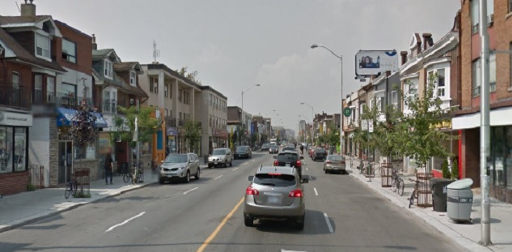
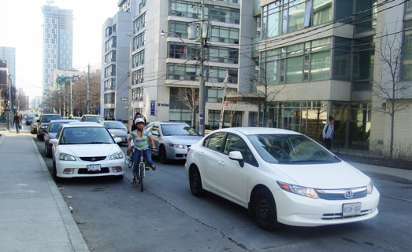
…to ‘sharrows’, a faint painted signal of recognition but still ambiguous and providing a false sense of security…
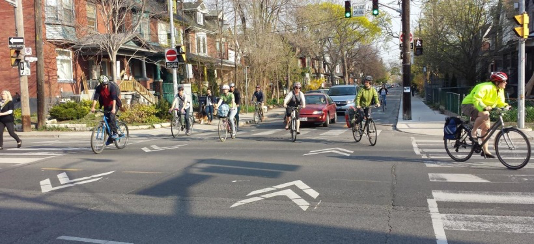
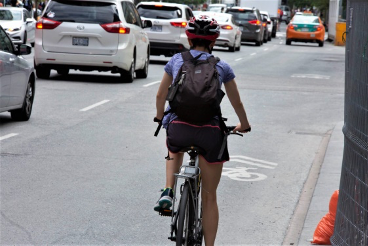
…to narrow or wider painted lines – a little better but still vulnerable, too easy for vehicles to cross or block with vehicles parked or stopped in lanes forcing cyclists out into moving traffic…
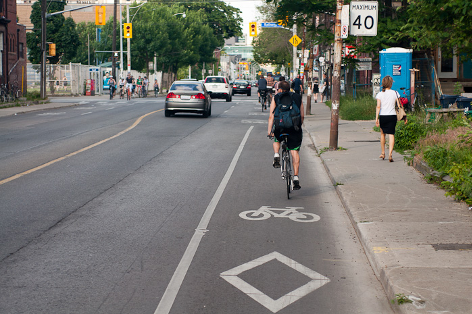
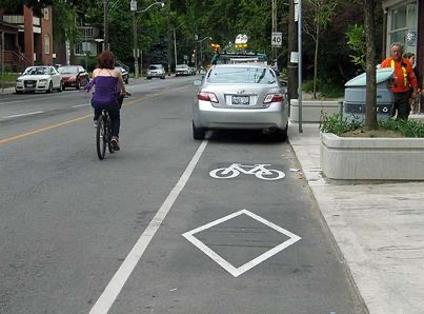
…to Covid inspired “Quiet Streets”; throughout the neighbourhoods on smaller streets…

…to clearly identified contraflow lanes on residential streets…

… to more emphatic painting identifying bike lanes to make it clear that we have rules for sharing, messaging to drivers to slow down and pay attention, to cyclists and cyclists to ride safely…

…to physical separation in the form of pickets and lanes inside a row of parked cars…

…to raised curbs and planters…
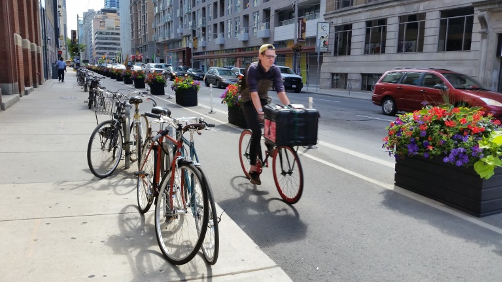

… to wider lanes, with designated left turns at the crosswalks and traffic lights with cyclist signals…

…to a new generation of integrated design with all users and movements accommodated in a completely blended shared street.

So far the redesign of Queens Quay is the exception that proves the rule even as its growing pains are being acknowledged and corrected.
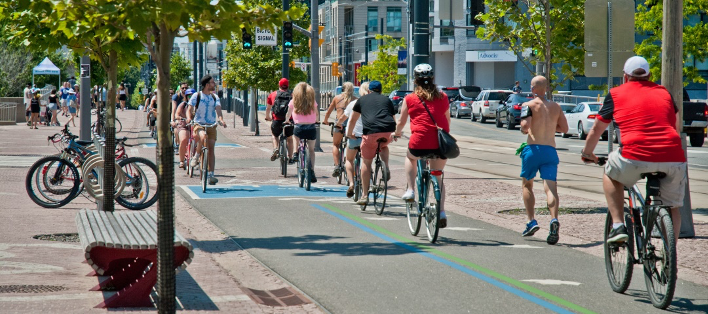
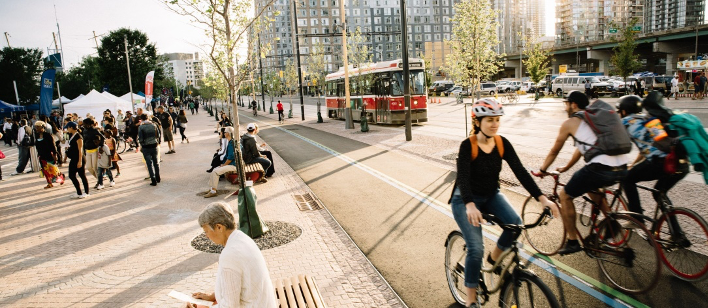
Then there are those euphoric and exhilarating moments when an entire street is liberated from vehicular traffic and the surrounding city can be appreciated in an entirely new way, encouraging many riders who do not currently feel safe cycling in the city to come out.
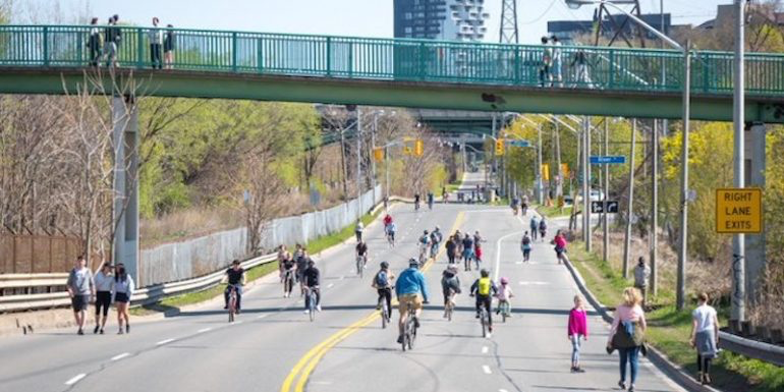
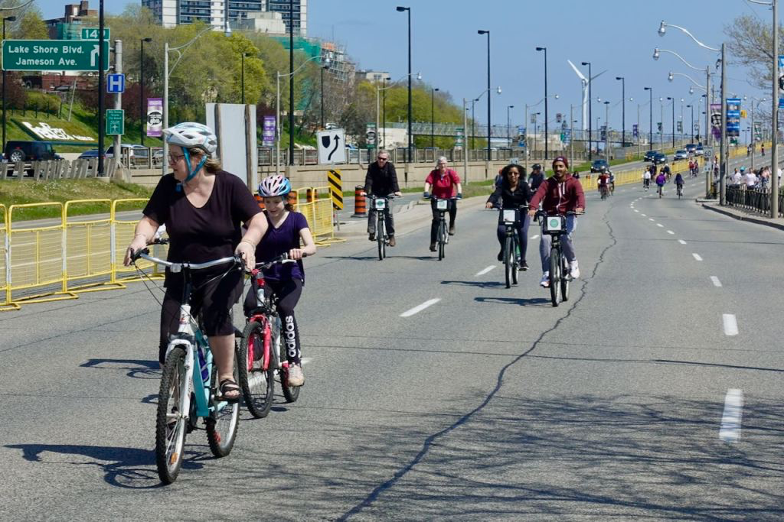
As these interventions proliferate, we are getting glimpses of what the city could be like. The experience of cycling (and walking) goes from one of anxiety to a sense of ease and security – slower heartbeat, more enjoyment of surroundings. As more people are induced to get on bikes to try it and feel safe, the city itself feels and becomes different. The change is palpable, perceived distances shrink, getting from place to place becomes intuitive. Through a Vision Zero lens the city becomes immeasurably safer for all users of all generations. And perhaps counter-intuitively for those who still need to drive, the greater the success of the network of SAFEWAYS, the more they benefit by freeing up space in the rights-of-way as more people use them and get out of their cars.
Step by step, and accelerated by Covid, we are moving form isolated fragments to forging connections and moving slowly closer to the holy grail of a fully connected network where there is no need to worry about how to safely make the next connection to get from A to B throughout the city. Amsterdam and Copenhagen are the gold standard thus far.

In our case five organizations have come together to produce an online community map of Toronto ‘SAFEWAYS’ tracking the evolution of our own emerging network. In a great display of community collaboration, these five Toronto-based organizations dedicated to improving and enhancing the city’s public realm have come together to advocate for safe and viable ways for Torontonians to navigate our city on foot and by active transportation. The initiative, led by Cycle Toronto, Walk Toronto, The Bentway, Park People and Spacing Magazine, illustrates our emerging network of bike lanes, multi-use trails, parks and ActiveTO closures for recreational and commuting purposes. These SAFEWAYS are both a critical response to the current moment and hold the key to a safe and sustainable post-Covid Future. This is what it looks like so far.

The digital work in progress map serves 2 purposes. It helps Torontonians access and use the SAFEWAYS we now have. It also sets the stage for what comes next, a new way of navigating the city as we continue to grow and complete the network not just downtown but throughout the city. The map is not about an end state but a beginning, to provide encouragement for further additions and improvements.
In this period of Covid 19 we have come to understand that this network of SAFEWAYS is not a frill or a non-essential “nice to have”. We were already in the midst of a public health crisis, exacerbated by sedentary lifestyles where an overreliance on the automobile and a tendency to spend long hours in front of screens has produced an epidemic of obesity as well as increases of diabetes and heart disease — especially alarming among children. This current situation has reinforced that need. A generously endowed and welcoming network of public SAFEWAYS provides a vital service and offers significant benefits for public health both physically and mentally.
The pattern of SAFEWAYS we have now is still fragmented and piecemeal, and parts of the city, particularly the inner suburbs, are not yet well served. There is now an opportunity to build on the momentum to develop a unique made-in-Toronto solution combining both on street and off street components, our unique ravine system with trail connections, and our vast network of over 2,400 laneways, which, combined, extend for more than 250 kilometres. Our future success depends on resourcefully exploiting these arteries and veins, which can be stitched together with hydro corridors, rail lines, stormwater management systems, flood-proofing plans, and related transportation initiatives, to address many of the city’s current deficiencies.
By transforming these underutilized spaces more creatively we create opportunities to link existing and new green spaces into continuous interconnected webs. The entire city has the potential to become more park-like, green, and connected for people on foot and on bicycle. There has been a dramatic and noticeable impact on the environment. The air is cleaner, nature is more evident, and we can hear sounds of city life that were drowned out by traffic. What we are seeing and feeling intermittently with the temporary closings on Bayview and Lakeshore Boulevard, is a vivid demonstration of how all ages including children and seniors are encouraged to experience these safe spaces on their bikes.
The entire city will benefit as it becomes more connected for people of all abilities and ages on foot and on bicycle, fostering residents’ ability to move around relatively freely and experience more of the city, in ways that break down perceived barriers between neighbourhoods and districts as flows become more continuous. With time, the examples of connection that we are creating ‘on the fly’ today must become the rule.

Can this pandemic show the way to a city laced with connected ‘Greenways’
Post Date: Thursday May 6, 2020
As the weather turns and restrictions begin to be lifted dozens of cities around the world from Berlin to Bogota, New York, Paris, Oakland, Milan and Vilnius, Vancouver, Calgary and, Brampton are responding to an irrepressible demand for safe outdoor space by rapidly turning over traffic lanes and in many cases entire streets to pedestrians and cyclists. This is both an answer for the desire to be outdoors while respecting physical distancing but also to addressing the practical need for new ways of moving around the city on foot and by bike to get to work and essential shopping. As this happens this response is revealing an entirely new way of seeing and using the city laced by interconnected “greenways” and as we experience the change, the momentum is unlikely to be reversed. We have been slow off the mark but this can also be Toronto’s opportunity to boldly join the parade.
This ‘improvised’ shift is dramatically accelerating a movement that was already underway. On the one hand, an increasing desire for urban living was leading to a greater need for shared public space. Meeting this need in traditional ways was thwarted by high land costs for acquiring traditional parks. The need for more space was accompanied by a change in how we use that public space and the kinds of experiences we seek, more fluid and interconnected, leading to new forms like linear “greenways” reflecting the shift from auto-dependent lifestyles to active movement — cycling and walking.
In the process, we were already moving from seeing public space as interconnected webs or networks. Coved 19 has now raised the ante. It begs the question of what our next public spaces will be as we continue to evolve into a great and densely populated city. Toronto has a wide range of existing parks, from expansive legacy parks, like the Toronto Islands and High Park, more intimate neighbourhood parks like Trinity Bellwoods, gardens and historic squares like Victoria Memorial Square, natural waterfront parks like the Eastern Beaches and Western Beaches, as well as a vast array of neighbourhood parks, some sixteen hundred, in fact.
We have also had a brilliant new round of renewal of existing parks, and creation of new ones, is underway in some areas. There is now a refurbished Grange Park behind the Art Gallery of Ontario with unique children’s play structures, and Berczy Park with its crowd-pleasing dog-inspired fountains; recent additions along the waterfront include Sugar Beach, with a sand beach and sturdy pink beach umbrellas; Sherbourne Common with its water filtration artworks; Corktown Common with a working wetlands; and Trillium Park with its cave like rock formations. And at the other end of the size spectrum, there is the new Rouge Park, the country’s largest urban national park, and the new sixteen-kilometre Meadoway, which utilizes a Hydro corridor to link Rouge Park to the Don Valley.
These new park spaces, however, even combined with existing parks, don’t even come close to fully meeting the city’s growing need, as the growing population is creating a Toronto that is literally bursting at the seams. A key demand of city residents, expressed over and over in community meetings about intensifying development, is the call for more and improved open space as part of an expanded public realm.
This has been our dilemma. How can Toronto get ahead of the intense development curve to shape a dynamic and growing city around a forward-looking program for expanding the public realm? The current moment offers some clues. It is not only about the quantity of public open space — in conventional planning terms, we have been focused on the square metres of parkland per inhabitant within a given radius — and while this is important, it is actually more important to focus on the quality and usefulness of that space and how it enhances our lives.
We are now seeing dramatically how public space is not a frill or a non-essential “nice to have.” A generously endowed and welcoming network of public space offers significant benefits to public health, both physically and mentally. We were already in the midst of a public health crisis, exacerbated by sedentary lifestyles where an overreliance on the automobile and a tendency to spend long hours in front of screens has produced an epidemic of obesity as well as increases of diabetes and heart disease — especially alarming among children. This put a premium on public spaces where people of all ages can get out and participate in active pastimes, from simply walking and cycling to a whole range of year-round sports and athletic activities close to where they live and work, making these health-promoting activities part of their daily life routines.
By transforming our underutilized spaces more creatively we create opportunities to link existing and new green spaces into continuous interconnected webs — linear greenways formed not just by conventional parks, but also trails and “green streets” of all scales. Our future success depends on us exploiting these arteries and veins, which can be stitched together utilizing our currently unsung hidden-in-plain-sight ravines, hydro corridors, and laneways. This stitching may be the key to our own genius loci in the public realm.
Toronto’s vast network of laneways offers another huge potential. There are over 2,400 laneways, which, combined, extend for more than 250 kilometres in length. In terms of area, the laneways occupy over 250 acres, an area more than half the size of High Park. More significantly, this mid-block network penetrates many of the city’s neighbourhoods, providing the potential for an intimate network of open public space, pedestrian and cycle routes, and extremely valuable land for housing, studios, workshops, and service spaces.
Putting together all these pieces — laneways, street redesign, ravines, hydro corridors, rail lines, stormwater management systems, flood-proofing plans, and transportation initiatives, a vastly expanded public realm can emerge, one that addresses many of the city’s current deficiencies. This new realm will be different, both in scale and kind. Rather than discrete public spaces carved out of a grid of street blocks — parks and squares — this new kind of public space has the potential to become the fully continuous, connective tissue of the urban fabric itself.
The entire city can become more park-like, green, and connected for people on foot and on bicycle. Fostering residents’ ability to move around relatively freely and experience more of the city this way will help to break down the perceived barriers between neighbourhoods and districts as flows become more continuous. The elements of the public realm that serve as links between areas will play a vital role in helping to make the city feel like a seamless whole.
With time, it can be anticipated that the examples of connection that we are creating ‘on the fly’ today have today will become the rule. With the shift to a more expansive sense of the public realm, a new liberating “reading” of the city will emerge, no longer orienting itself only or primarily by highways and major arterials but increasingly by connected networks of common space serving as guideways throughout the city. This more fluid idea of the entire cityscape as a landscape, where flows become more organic and seamless in some ways gets us back to a pre-colonial sense of the land we inhabit as a generous shared “commons,” less hard-edged and hemmed into narrow sidewalks by speeding traffic.
Cities That Heal: How The Coronavirus Pandemic Could Change Urban Design
Post Date: Tuesday, April 28, 2020
Can we design cities that heal? Listen to my conversation in the link below with Megna Chakrabarti of NPR’s ON POINT and Architect Michael Murphy about how to change the cities and buildings for better human health.

How Covid 19 is forcing us to acknowledge our place in the natural world
Post Date: Thursday April 24, 2020
Steven I. Apfelbaum, (my ecologist colleague and friend from Wisconsin) and I have worked together for over thirty years. We have learned a great deal from each other. He has been truly mesmerized “learning about urban systems, structure, functions and why unhealth and healthy conditions develop. And, I have been excited to see practical and cost effective ways to bring nature and green infrastructure into urban systems, into our lives, our community and neighborhoods. Nature and urban systems can be wonderfully complimentary is what we have both learned. Books by Steve such as “Nature’s Second Chance” (Beacon press), and a series, “Restoring Ecological Health to Your Land” (Island press), may be of interest.
Steve sees the COVID pandemic within a broader context. One in which we now have the “bulls eye on our back”, while for decades we have assaulted nearly all other life and natural resources on earth with pandemics, where the bulls eye is on the back of natural areas, migratory birds, marine fishes…when the pandemic was delivered by us, instead of a virus, we have been the agent of upheaval.
He has shared this remarkable prose poem with me:
UNDERSTANDING PANDEMICS
IS THIS YOUR FIRST RODEO
We recognize when the bullseye is on our back.
We hide and cower in fear NOW, with the uncertainty of our survival.
Neighbors are dying, never to be visited with again,
Families fear one another getting sick.
We don’t understand nor have confidence we can be treated
-
Doctors, nurses, and volunteers from the world over are playing MGyiver to keep us breathing
NO, IT’S NOT YOUR FIRST RODEO
Industrial agriculture is the equivalent of a pandemic assault on sustainable farming in America
Benign neglect for ecosystem health is the equivalent of a pandemic assault on ecosystems
Over harvesting of marine fish resources is the equivalent of a pandemic assault on fish stocks globally
Spilling of pollutants into rivers, coastal zones, lakes, and into ground water is the equivalent of a pandemic assault on water resources on earth.
The human population explosion is having pandemic effects on all of nature
Human demand for natural resources is stripping the cupboard of nature bare, just like the pandemic effects in our food stores with COVID-19.
Our own assault on our gut microbiome is a pandemic on the hoof, waiting to stampede us down.
Hunger and poverty occurs beyond our blind eye—this is a growing pandemic
Habitat and biodiversity decline on earth has been our signature behavior as a species
WHEN THE SYSTEM THROWS YOU, IN THIS GAME YOU DON’T GET BACK ON THE HORSE QUICKLY---YOU GET TRAMPLED AND ALL CHANGES IN NATURE ARE FAIR GAME
Assaults on nature come back to bite us--- recall, nature bats last.
A pandemic that goes around will come back to us--- Turnabout is fair play in nature.
Finally, we realize we are not separate from nature—not above or below, but part of nature
Our world has been turned topsy-turvy by all measures—we have lost our freedoms (or suffer the consequences and risks)
Our 401k’s have become the food of uncertainty-
Leadership not from above, where aloofness and ignorance and hubris prevail --no genius, no humanist; but from scientists, and medical professionals
Our political divide is a pandemic
SO, PERHAPS NOW YOU FEEL A NEW PANDEMIC, BECAUSE IT IS THE ONE AIMED AT YOU
An assault on nature, the health of the earth is surely cutting the very heart out of our civilization, humanity, our economy, our lives
Business as usual will never work again.
Ignoring the inevitable future and other looming risks will not be sane,
Not caring because it’s too complex will no longer be an excuse
-
Voting with your purchasing power will no longer be a method to rapidly scale success
SO, WHAT SHOULD WE LEARN?
Nature will double back and outsmart our every move
This chess game is more complex and is deadly serious
As we’ve learned, we can’t be inoculated in time against pandemics
Recognize the fast moving freight train (COPID-19) has derailed us beyond any prediction
Recognize the slow moving tsunami (Climate change) will upheave us, move us from the land, dismantle our food supplies, directly displacing hundreds of millions.
Recognize diseases, viruses, pestilence, and everything unimaginable is waiting in the lurch for the moment to pounce upon climate change victims.
SO, WHATS TO BE DONE NOW—GETTING THROUGH THIS ONE ISNT THE QUESTION
Regain our composure and sense of place in nature
Assume culpability for our assaults—myriad pandemics we have directed at nature, each other.
Nurture nature--- give back to unsoil our nest, from the havoc we have wreaked.
Assume Responsibility to replenish, repair, reinvigorate, restore nature, healthy soils, healthy food supplies, healthy humans
Assume a Humble role, as a part of the earths system of life, and follow the rules and regulations of nature
Make wise choices grounded in wisdom, not frivolity, and an “aw shucks” attitude to guiding our collective future
Choose leaders grounded in science, understandings, not self-fabricated mythology, or ungrounded fantasy
Avoid Complacency--- New pandemics are boiling up daily with the bullseye on our back.
No Double Standards--- It doesn’t matter who the bulls eye marks ( e.g. black, white, Soudanese, American, republicans, democrats, socialists, etc. ) —invest in solutions for all mankind, all nature.
The Old Finger in the Dike Trick will not work--- An outbreak anywhere becomes a risk everywhere, to everyone.
Work Together--- no barriers --- all must be dismantled, one human civilization must be recognized
-
Rationally view this omnipresent, omnipotent crisis as a wake-up!
SO, HOW DO WE UNDERSTAND SUCCESS?
When Nature celebrates the resurgence of vital and vibrant life on earth!
-
Some of us will be invited to the party!
Steven I. Apfelbaum, Juda, WI, April 11, 2020
steve@appliedeco.com

What might the post Covid 19 world mean for the city?
Post Date: Thursday April 16, 2020
In this moment of crisis we are witnessing remarkable examples of turning on a dime, of coming together to make the impossible possible, allowing ourselves to try new things and experiment. Can we capitalize on that momentum when the peak passes and we focus on renewal of our cities?
Before the pandemic arrived were already in md-stages of a major paradigm shift from away from a post WWII environment that had been built around the car, attempting to create inherently more sustainable urban places. Cities around the world were working through this transformation as part of a great collective learning curve. While progress was being made one could argue that it has been sometimes frustratingly slow and uneven.
In a best case scenario can we use this force majeure of the Covid 19 crisis to accelerate innovation and adopt new practices and strategies for building better cities in the way that shared crises of the past led to similar farsighted responses? The Great Depression brought us the New Deal and Unemployment Insurance. The series of devastating contagions in the 20th century led to great advances in vaccination and public health. Can this be an equivalent shape-shifting turning point for cities?
The to do list we were working on is still there: reintegrating the activities of city life in mixed-use, mixed income walkable settings, changing how we move, re-setting our relationship to the natural world, dealing with the challenges of climate change, expanding common ground. But now those goals have been overtaken by an expanded set imperatives coming out of Covid 19, piggybacking on and potentially driving the first with a heightened sense of urgency and new possibility.
The defencelessness of disadvantaged populations, the lack of attention to public health, the extraordinary retreat into a digital world, the need for strong and reliable government and public services, the power of civil society and the deep well of generosity and caring of the public, all speak to the need to strengthen the inherent capacities of the city to be more resourceful and resilient. To get there will require unprecedented levels of collaboration, a sharing of resources, new forms of partnership, and a willingness to step out of established silos.
A number of things have come into high relief as a result of the Covid 19 pandemic which might propel this shift. While the failure to address marginalized and disadvantaged populations is certainly not news, we have disastrously failed to act and have seen the consequences. Community health depends on making our cities and city regions more equitable and this underlines the need to give our public health officials a prominent place at the planning and urban design table. Malcolm Gladwell in the Munk Debates has used this persuasive analogy: If you want to improve the performance of a soccer team, it is important to improve the worst player on the team not to lavish attention on the stars.
Yes we are in this together but not experiencing the pandemic in the same way. The focus on highly sophisticated medical treatments available to a small percent of the population in the US exists alongside a huge population of uninsured; great hospitals but an appalling lack of attention to public health among the poor. These weak links have contributed to making it the hardest hit country in the world. In Canada the festering problems of long term care facilities have been well known and now are producing an astonishing death rate.
Can we learn from this painful wake-up call and make cities that are more equitable? This is particularly relevant for Canada with our great collective project of successfully absorbing migration from around the world to make our cities the most diverse on the planet.
A second revelation has been the immediate and virtually total reliance on the digital world imposed by physical distancing. This is forcing us to come to terms with issues already in play around data security and privacy, but also the need to figure out the role we want this technology to play in our lives and our cities. How can we make best use of technology to advance a human centred urbanism and not allow it to permanently distance ourselves from each other? I am persuaded that when this is over we will want more than ever to be together physically and not seek to ‘cocoon’, combining the best of IRL (in real life) with our expanded digital presence.
A third revelation has been the value of ‘redundancy’ as the cornerstone of resiliency, having multiple ways of doing things so that when one ‘system’ or ‘network’ breaks down we have recourse to others: the abrupt shift to virtual communication to achieve physical distancing being a prime example, but also multiple ways of getting access to food, moving around the city, walking, cycling, using thinned out transit and yes, cars; adapting spaces and institutions to new uses, seeing hotels become shelter housing, libraries doubling as food banks etc. This need for redundancy also applies to alternatives to tenuous supply chains, the need to keep local manufacturing capability and local agriculture for food security. We need to think of value engineering ‘in’ redundancy in cities for unforeseen and unpredictable events.
We have been jolted into acknowledging the essential role of governments and the need for trust and confidence in their ability to act decisively and provide leadership. The talk of leaving everything to the private sector and disparaging the public sector has significantly quieted. At the same time the strength of civil society has been remarkable and its capacity for generous ‘caremongering’ is awesome to behold. Perhaps this will lead to a new and better understanding of these complementary roles and how they can be mobilized to make meaningful change.
Finally the actions we are witnessing give some hope about our collective ability to mount a response to the even more existentially consequential, if less immediately dramatic challenge of our age, that of facing global warming and climate change. An initial knee jerk reaction declaring that density the enemy is based on a false correlation, conflating density with overcrowding. It has to be resisted, lest it lead to a renewal of low density sprawl, setting back decades of effort. The key is to do density well in in our cities in a way that addresses both challenges simultaneously.
Two things in particular emerge as urgent priorities in light of the experience of the pandemic, making the city more equitable and making it more resilient. The urban ‘neighbourhood’ is a good intermediate scale to see how this may play out. The illustration above shows how a portion of the post war suburban landscape of strip malls in Brampton can be reconceived as a 20 minute neighbourhood.
This is part of a work-in-progress initiative I have been working on with colleagues at the city which reflects the aspirations the city has endorsed in Brampton’s 2040 Vision. There are no silver bullets; there is no big bang, but it is about proximity and overlap, how things normally widely separated, are woven together in the neighbourhood in innovative ways challenging previous assumptions and formulas. So what does that look like?
The image portrays a compact neighbourhood setting where many daily life needs can be met within a 20 minute walking distance with the density and diversity to support this. The neighbourhood is anchored by a ‘community hub’ linked to park space. It combines public and separate elementary schools, a library (which we have seen can be an extraordinary resource), a community and recreation centre, daycare, arts and culture, and spaces for entrepreneurial start-ups.
Public spaces are shared and adaptable for efficiency and to foster interaction among different users of the neighbourhood throughout the day and week. Indoor spaces flow transparently into outdoor spaces and can be adjusted for seasonal comfort and cordoned off for security or safety when needed.
There is a full mix of housing for the full range of the population in terms of age, income, household types and needs including seniors and young families with kids drawn by easy access to the community hub. There is a mix of ownership and rental options with different levels of subsidy to foster inclusion. People who work in the community can also afford to live there and the population can age in place within the neighbourhood as life circumstances change. The diverse architecture and built form reflect the social diversity, with buildings of different scales including the elusive “missing middle” of mid-rise structures. The dwelling units themselves are conceived with adaptable space for work and home schooling for moments like the one we are currently living through.
There is a lively daytime population in the neighbourhood with work in many forms from live/work to office space, incubation start-ups and space for collaboration including a mix of small businesses and maker spaces. There is neighbourhood shopping for food and other basic needs, restaurants, cafes providing informal sociable gathering places.
There are many ways to get around. This neighbourhood is not a self-contained village but part of larger city and region. The street types have been designed to prioritize transit, cycling and walking but there is room for cars as well, including car share options and ultimately autonomous vehicles. Sidewalks are generous and universal accessibility is the rule.
Space allocation within the rights-of-way can be redistributed as needed for different modes, for example when more space is needed for physical distancing. Parking is shared and designed to be repurposed when no longer required.
An expansive public realm, ‘common ground’ is a key feature of the neighbourhood. It turns out we need it more than ever. Park space serves many uses and users and is the essential social glue that ties the neighbourhood together and fosters the interaction that unites us in times of crisis. It is enlivened by opportunities for everything from sports and recreation, community gardens, to arts and culture which celebrate neighbourhood life and reinforce a sense of shared identity. Even overlook from balconies becomes part of the shared experience of the public realm as we have learned when confined to our units.
The neighbourhood expresses its deep relationship to the natural world and its commitment to environmental sustainability in the way it handles energy, waste, mobility and storm water integrated within the parks and open spaces. It demonstrates how we can break our dependence on fossil fuels and move toward the goal of net zero or energy plus.
You might say all these things are just normal and you would be right. Few if any of these ideas are absolutely new. Many have been there for the taking. The most important learning that can come from the Covid 19 pandemic is that when motivated we have the potential to rapidly expand the range of the possible. We have it in our power to overcome inertia and make real changes that would take us to more equitable and resilient cities.
We then need to treat this experience of society mobilizing in a crisis as a dress rehearsal for confronting the next great challenge of climate change.
Optimism <> Pessimism
Post Date: Sunday April 12, 2020
It has been almost a month since I last went to any kind of gathering with other people and the fact of isolation is really sinking in. The holidays, Passover, Easter and Ramadan feel like a marker, a time to take stock in this passage from one reality to another. The world has gotten a whole lot smaller physically and expanded virtually. New routines have taken hold and are punctuating the days and weeks in new ways.
There are some significant revelations. We have learned that there is depth in government and in civil society that can be mobilized when there is a will and an urgent need. People, politicians are seen for who they truly are – qualities of steadiness and courage, and selflessness on the one hand and on the other mendacity, pettiness and seeking of partisan advantage. There are real surprises like our Premier Doug Ford stepping up in unexpected ways and forging alliances.
We are seeing that things that seemed impossible, that were postponed and neglected can actually be done. The failings in our systems and social safety network have been dramatically exposed and the people who were ignored in precarious situations have now been made highly visible.
The world is now truly connected; it is ‘globalized’ in that we are all vulnerable together in the face of this pathogen, which like climate change, can’t be solved by any group or nation alone. But globalization of the economy is revealed as a two edged sword. We are seeing the high price we have been paying for ‘cheap goods’ and services that enabled a certain lifestyle but led to tenuous supply chains for essentials, loss of local capacity and the precarity of the gig economy.
The limited ability of the private market, the working out of supply and demand, to address many basic needs has been painfully exposed from housing to health care itself especially in the US with its millions of uninsured. We are seeing with new eyes those whose work is indispensable for our survival, the unsung heroes in the health care, first responders and service sectors many of whom have been ill-paid and without benefits and support who are now risking their lives.
The so-called austerity agenda has made us ill prepared, short staffed and vulnerable. There is no free lunch. We have to redress the public/private balance and pay for what we need to keep whole and safe through taxes. The creation and manufacturing of the vaccine that will rescue us from this scourge will require vast public resources, a global sharing of information among scientists and free distribution on a world wide scale.
Fundamental questions of security, data privacy civil liberties and social discipline have all been raised in relation to our ability to sustain an open democratic society. These are all very big questions but perhaps the biggest on most of our minds is how will this end or will it? When and how will it be safe to be out in the world again?
There is no doubt that the Corona 19 pandemic is a force majeure. It cannot be ignored. Nature through this pathogen has got the world’s rapt attention (with the exclusion of some incomprehensible deniers). Even wars are being put on hold like the endless struggle in Yemen.
So what happens next? There seem to be three views emerging: 1) More of the same; 2) A wake-up call; 3) Regression to autocratic insularity. Historian Richard Haass argues the first in his piece “The Pandemic Will Accelerate History Rather Than Reshape It”. Delcan Walsh takes the third view that “the world’s strongmen are reverting to their standard playbook to project an aura of control".
And then there is this more optimistic second view which I share from yesterday’s Toronto Star Editorial praising the steps taken in Toronto re the housing crisis. It points to the fact that there is nothing like a pandemic that forces people to distance themselves to really focus attention on the fact that tens of thousands of Canadians don’t have a room of their own, let alone a home, in which to do that. To respond the city has scrambled “to open up new emergency shelter spaces and snap up entire hotels to allow for the physical distancing that is so essential in the collective fight against the coronavirus”.
These changes that are being made on an emergency basis must now be used as a starting point for permanent change. The actions that Toronto and other cities are taking demonstrate that when we marshal the right resources we can effect change. It also shows that governments already know what needs to be done and how to do it.
It is now imperative that all levels of government ensure that we don’t go back to the old and completely inadequate way of doing things once better times return. “That homeless people’s situation could improve in the midst of a global pandemic says a lot about how bad their “normal” situation is, and why it’s so imperative that we continue to move forward.”
Do we really have a choice? This unsettling article in the New Yorker by Matthew Hutson on “The Quest for a Pandemic Pill” alerts us to the fact that the Corona 19 pandemic is likely not a one off. There will be more, the question being not if but when. To prepare ourselves will require incredible levels of world-wide focus and cooperation. Can we do that? This will require new models for how we do just about everything. We will come together or go down together.

Hundreds of Points of Light
Post Date: Friday April 10, 2020
A big shoutout to CityShare/ Canada This real-time crowdsourced platform available in both French and English shows how we are collectively responding to Covid 19 with remarkable ingenuity and generosity. All across the country there are ground up initiatives to fill unmet needs and help people to reach out to each other. At the time of this writing there were over 400 initiatives from every quarter, from the CBC, Community Colleges, First Nations, Public Libraries, to companies, unions, agencies, individuals and groups of all kinds with advice on getting access to everything from women’s shelters to housing for healthcare workers with links, interactive maps and sourcing for volunteers, it shows our extraordinary capacity for improvising in the face of a crisis and system gaps.
We are a generous and resourceful people. While we definitely need, more than ever, the capacity of government and its ability to deliver programs at scale for all of us, this kind of ground up response is the essential counterpoint. It is a direct and immediate human response enabled now by the digital world to decentralize and democratize, to tap into people power. This is yet another example of a legacy forged under duress that we will ideally carry forward.

This Night was Truly Different
Post Date: Thursday April 9, 2020.
This cartoon is humorous because it is absolutely true. This is exactly how my family got together on Zoom for the 2 nights of Passover. The question is one of the ‘4 Questions” usually asked by the youngest child at the Seder table to elicit the telling of the story of the Exodus and liberation from bondage. It is doubly poignant now because we are all in a peculiar form of bondage not imposed by one nation or group on another but by an invisible microscopic virus that is carried by each of us. We are for the moment each other’s bondsmen.
There has always been an aspect of universality to the telling this liberation story. It usually leads from the account of the freeing of the Israelites in biblical times to calling attention to the plight of others who have suffered and are still suffering in similar ways. And there is another aspect of universality. Passover, Easter and Ramadan all fall roughly at the same time and signal the arrival of spring and new beginnings. Cementing this commonality there have been a series of broadcasts with Rabbis, Pastors and Imams all on air together talking about how they and their congregations are all improvising to deal with this common need to celebrate together and to stay together in spite of physical distancing.
The urge to connect, to see each other at this time is powerful, to experience if not the actual taste of the special food we would have shared and vicariously imagine that we are enjoying it together. We do the best we can with the technology available. Another inspiring example is this video of the Israel Philharmonic orchestra playing a Passover medley, each member at home but still very much together.
After getting together online Eti and I were out on the balcony with our pots and pans to make some noise and express our thanks for the dedicated health care workers. Every night there are a few more of us. This nightly ritual is one of the few opportunities we have to actually see each other and affirm that we are still here. The balconies which were essentially very private have taken on a new meaning as shared public space.

Cracks in the Sidewalk?
Post Date: Wednesday April 8, 2020.
Jordan Himmelfarb writes about an unwarranted fear of social breakdown as a result of impacts of Covid 19. It is impressive how people have supported the actions of our governments in Canada despite the fact that we have essentially shut down the economy to observe physical distance, and there has been a remarkable lack of partisan bickering or gamesmanship. In many ways we seem to be pulling together. We are taking bold steps and trusting the advice we are getting from public health experts.
What we are not seeing so far is a “dystopia of crumbled institutions and adversarial individualism”. Sacrifices are being made to protect ourselves and each other. Neighbours helping others and front line workers taking great risks to help all of us. One of the important takeaways is the power of collective action in the face of adversity. This is an important antidote the declining trust in government, in evidence and in expertise that we were perhaps seeing prior to the advent of the virus. The key question is will this stick. Will we, Jordan Himmelfarb asks, remember how we got through this together? Will it have a lasting impact and enable us to make fundamental changes in other areas that have gone begging for cohesive action to maintain this sense of solidarity?
Through the harsh light of the pandemic we are seeing significant frays in the social fabric, inequities which have been there all along. They are showing up in who is most vulnerable. In many case it is the very people we now depend on most, the underpaid service workers, those who are poorly housed, who have insecure employment and few benefits, who are unable to shift to working from home, who are most at risk.
One clue in Toronto is who has to take the bus every morning to endure a harrowing commute, the part-time cleaners, the delivery people and others who are now providing essential services. While the TTC is reporting losses of 80% system wide some bus routes are still crowded particularly in the city’s northwest and southwest industrial areas where wages are low for shift work and there is no choice, and in neighbourhoods identified by the city as having a higher percentage of low-income households and lower access to jobs.
There is a social, economic and racial justice issue. In the US we have seen black Americans dying in disproportionate numbers. This disparity is stark in cities like New Orleans, Chicago and Detroit. In Chicago, for example where only 30% of the population is black, they account for 70% of all coronavirus cases in the city and more than half of the deaths in the state.
There are a number of factors at work including concentration in urban areas and working in essential industries with only 20% of black workers reporting that they can work from home. There is also a high prevalence of Covid-19 among those suffering from obesity, high blood pressure and diabetes –more common among black Americans. Clearly an aggravating factor is the lack of access to health insurance.
The heightened vulnerabilities revealed by the pandemic for different parts of our population are a powerful call for action. There is no escape from our interdependence. How one community is treated affects all communities. This has major implications for social equity in our cities - decent housing, job security and reliable health care for all.








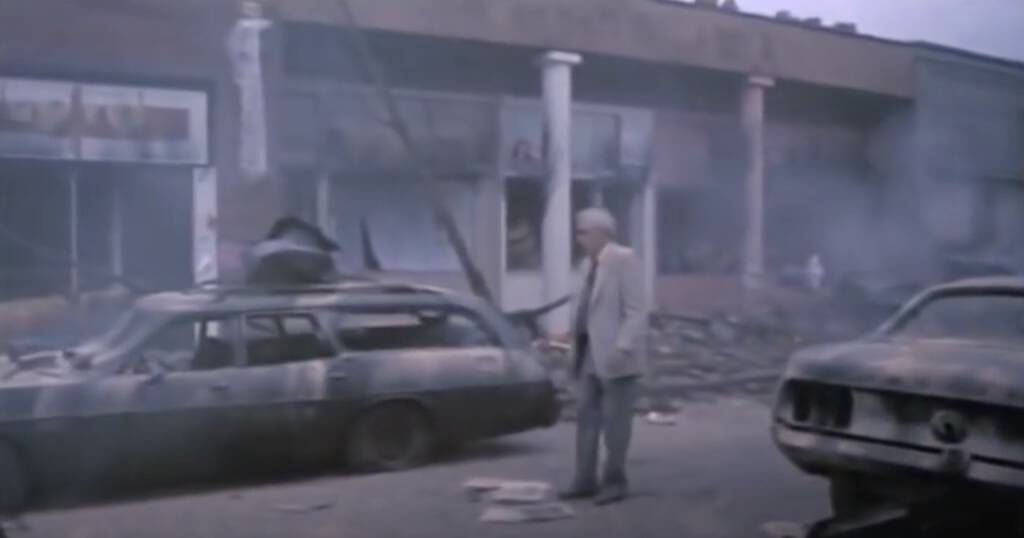
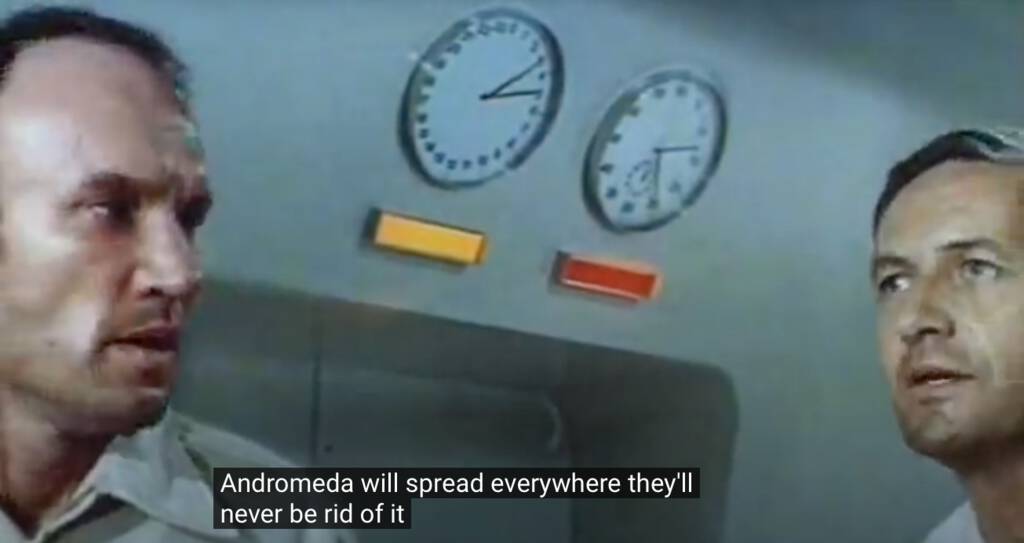








 (@paperichie)
(@paperichie) 